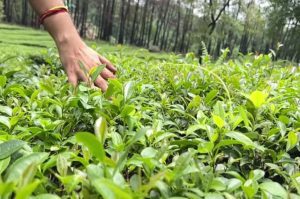Tea Under Crop Insurance Scheme: On June 10, 2025, the Union Ministry of Agriculture & Farmers Welfare issued a circular announcing the inclusion of tea and other major plantation crops—such as coconut, palm, cardamom, and rubber—under the Restructured Weather-Based Crop Insurance Scheme (RWBCIS), a first-of-its-kind step for India’s extensive tea sector.
Previously reserved for annual cereals, pulses, and some horticulture crops, RWBCIS now officially spans tea plantations across West Bengal, Assam, Kerala, and Tamil Nadu, offering improved protection against weather-driven crop loss. This move benefits around 1.5 lakh small tea growers, marking a significant milestone in agricultural risk management.

2. The Plight of Small Tea Growers
Who Are They?
Most beneficiaries are smallholder growers with 1–5 acre holdings, vital contributors to India’s tea economy:
- West Bengal: ~50,000 small growers in North Dinajpur, Darjeeling, Jalpaiguri, Alipurduar, and Cooch Behar
- Assam & other states: Remaining growers under CISTA [Confederation of Indian Small Tea Growers Associations]
Small tea growers contribute over 50% of India’s tea output, yet they have endured significant unmitigated losses from erratic rain, frost, and high winds.
3. Why Tea Insurance Matters
Unlike staple crops, tea faces year-round climatic risks—torrential downpours, untimely frost, hail, and insect outbreaks—that severely impact leaf yield and quality. The absence of insurance has long exacerbated:
- Financial vulnerability during adverse weather
- Reluctance to invest in healthy farming practices
- Dependence on unreliable, unregulated crop agents
4. RWBCIS Explained
How It Works
- Index-based payouts triggered by weather parameters (rainfall, temperature) rather than field-level loss assessment
- Designed for quick claim settlement, enhancing liquidity for growers
Rollout Protocol
- States must tender for private insurer participation by June 20, 2025
- Coverage starts in the upcoming kharif season (June–Oct 2025)
5. Grower Reactions & Industry Flavour
- Bijoy Gopal Chakraborty (CISTA President):
“It is a long‑awaited and welcome move”—relief for growers hit by frequent crop losses - NECSTGA (Assam):
—Earlier demanded weather-based insurance for tea and advocated for MSP and regulation of leaf agents
This consensus reflects the policy’s resonance across regions and scales of operation.
6. Insurance vs. MSP & Price Risks
While crop insurance helps mitigate weather-related losses, growers also grapple with price volatility and market manipulation:
- NECSTGA reports distress due to imported teas undercutting domestic supply, despite the Tea Board’s directive to close plucking early.
- MSP-like mechanisms remain under discussion, but coverage under RWBCIS is a critical step in risk buffering
7. Technical Challenges & State Coordination
Calibration
States must finalize weather station term sheets, insurer contracts, premium rates, and define critical thresholds ahead of the 2025 Kharif season.
Institutional Framework
Successful execution depends on collaboration among:
- Union’s DA&FW
- State agriculture departments
- Tea Board of India, Commodity Boards
- Private insurers and grower bodies (CISTA, NECSTGA)
8. Coverage Beyond Tea
By bringing tea under RWBCIS, the Centre has signaled expansion to other plantation crops like coconut, palm, cardamom, and rubber—key livelihood assets in agrarian economies focused on horticulture.
9. Climate & Agri‑Insurance Trends
Rising Demand
Climate variability has wrecked 33.9 Mha of cropland between 2015–21. As smallholders face compounding climatic threats, insurance offers a safety net.
Global Alignment
Index-based schemes are increasingly embraced worldwide for plantation crops. India’s inclusion of tea signals adoption of climate-resilient agricultural models tailored to local requirements.

10. Farmer Finance & Inclusion Impacts
Insurance transforms the economics of farming:
- Enhances bank and NBFC credit access
- Shields investments in improved bushes, irrigation, fertiliser
- Potentially fosters FPO formation for better bargaining power
11. State-Level Dynamics & Implementation
West Bengal
With 50,000 growers, West Bengal must orchestrate administrative readiness—governmental budget approvals and private insurance selection mechanisms will determine rollout success.
Assam & Kerala
Already driven by active grower movements, these states will likely mirror WB’s approach, but coordination, outreach, and data calibration remain essential.
12. Future Extensions: Toward MSP & Value Addition
While weather insurance is crucial, growers continue pressing for:
- MSP guarantee or fair-trade pricing
- Regulation of leaf‑buying agents to reduce chain exploitation
- Establishment of Small Tea Growers’ Directorate at national/state levels (As in Assam)
13. Success Indicators & Monitoring
KPIs to watch:
- Budget allocation and RBI-backed credit penetration
- Grower enrolment (% of small tea operations)
- Climate event-triggered payouts and timeliness
- Farmer satisfaction and re-enrolment rates
The Ministry will likely track implementation and publish evaluations post-2025.
14. Expert Commentary
Agro-insurance analyst Doreen Ware commented:
“Tea growers face extreme vulnerability—index insurance will be a game-changer in liquidity and risk management”
CISTA’s Bijoy Gopal Chakraborty added:
“We have been advocating for this for years… Now, we hope it creates real change for growers’ livelihoods.”
15. International Tea Ecosystem
- Competing tea-exporting nations like Kenya and Sri Lanka offer well-established insurance and supports.
- India’s policy leap improves competitiveness, resilient supply chains, and export stability.
16. Risks & Roadblocks
- Tender delays could push coverage to 2026
- Private insurer participation may be uneven, leading to gaps
- Data paucity in weather stations could hinder accurate payout triggers
States are expected to pilot initial rounds and evolve coverage via lessons learned.
17. Tea Under Crop Insurance Scheme: Long-Term Vision
Policy aspirations include:
- Mandatory insurance for all growers via Kisan Credit Card linkage
- Digitalised platforms for policy enrolment, claim tracking
- Integration with soil health, export, and certification programmes
18. Recommendations for Stakeholders
For Growers: Engage early, form collectives for scale.
For States: Prioritize tendering, capacity building, and awareness drives.
For Researchers: Track payout efficacy, farmer adoption, and scheme design.
For Insurers: Leverage digital tools and reach field level for better service delivery.
19. Summary & Outlook
In essence, the decision to bring tea under crop insurance is a transformative moment for small-scale cultivators, aligning with national goals around agricultural sustainability, climate resilience, and rural welfare. As policy transitions into field action, the real success of this initiative will rely on collaborative execution, transparent data systems, and farmer-centered implementation.
DO FOLLOW:
Ministry of Agriculture & Farmers Welfare: Revised Operational Guidelines – PMFBY & RWBCIS (PDF)
Parliamentary Q&A Document: Lok Sabha response detailing inclusion of perennial crops under RWBCIS
Also read: Home | Channel 6 Network – Latest News, Breaking Updates: Politics, Business, Tech & More

